Historique de la logistique des opérations de débarquement
English Translation
C’est la capacité d’assurer le ravitaillement des troupes débarquées sur des plages inaccessibles aux navires avec un grand tirant d eau ou lorsque les installations portuaires sont inaccessibles ou inexistantes
Historique des opérations
Guerre de Troie guerre XIII ° AV JC
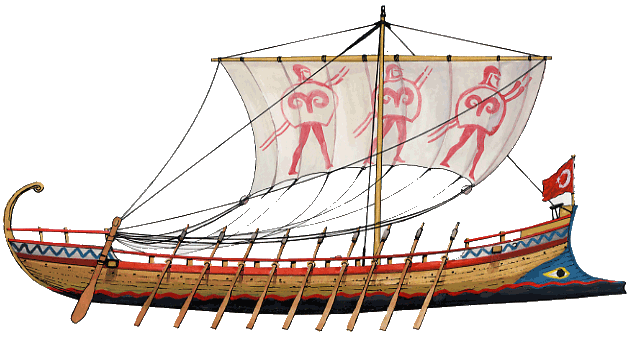 |
| Navire Mycénien |
Pour venger son honneur (son épouse Hélène a été enlevée par Paris fils du roi de Troie Ménélas roi de Sparte avec son frère Agamemnon roi de Mycènes réunissent une force amphibie de 1000 navires et avec l'aide d'autres rois grecs en ils attaquent la ville de Troie dont Priam est le roi Les Grecs traversent toute la mer Egée pour débarquer sur la plage près de Troie.
La guerre va durer 10 ans
Guerres Médiques V° siècle AV JC
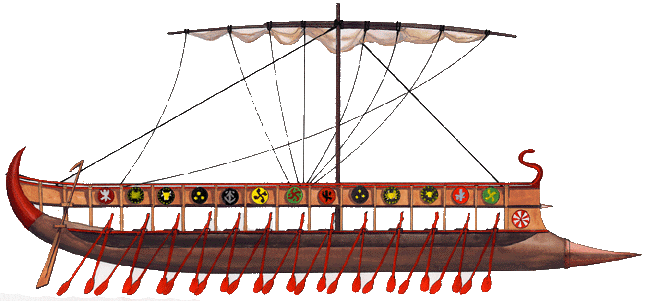 |
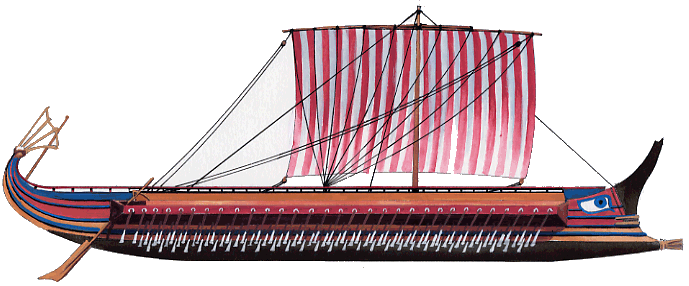 |
| Navire Phénicien (Flotte perse) |
Triere Athenienne |
700 ans plus tard, le roi perse Darius, se lance dans une guerre contre les Grecs en 490 avant JC.
Darius construit une flotte amphibie conçue pour une attaque sur Athènes. Ses navires sont les ancêtres très lointains des LCM et chaland de débarquement avec notamment un navire de débarquement des chevaux à terre. Cette «LCH» (engins de débarquement, cheval) n'a pas servi car Darius a été entre temps vaincu à Salamine
Syracuse 413 AV JC
.gif) |
| Syracuse ( Internet) |
le siège de Syracuse en Sicile par les Athéniens, mais la cité aidée par Sparte résiste et les athéniens sont défaits
Conquête de la Bretagne (Albion) par les Romains
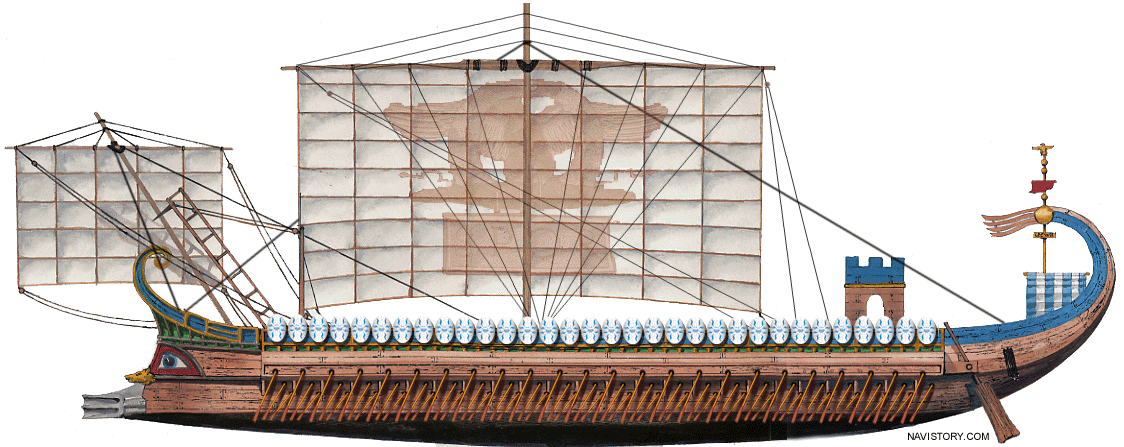 |
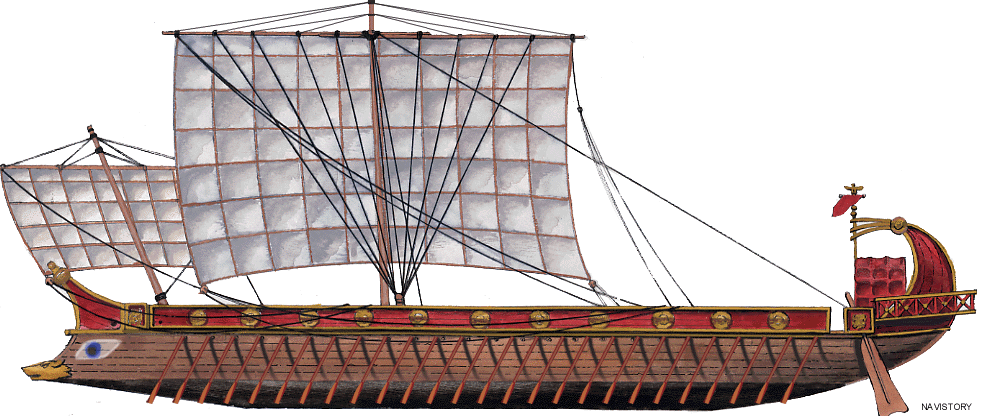 |
| Trieme Romaine |
Pentacontere Romaine |
En trois temps Dans 55 AV JC Jules César débarque avec deux légions temporairement en Bretagne, mais se retire . Un an plus tard, il retour et bas le roi anglais Cassioelaunus
La conquête sera effective sous le règne de Claude.
Invasion Angleterre 1066 par Guillaume le Conquérant
 |
 |
| Tapisserie de Bayeux |
Tapisserie de Bayeux |
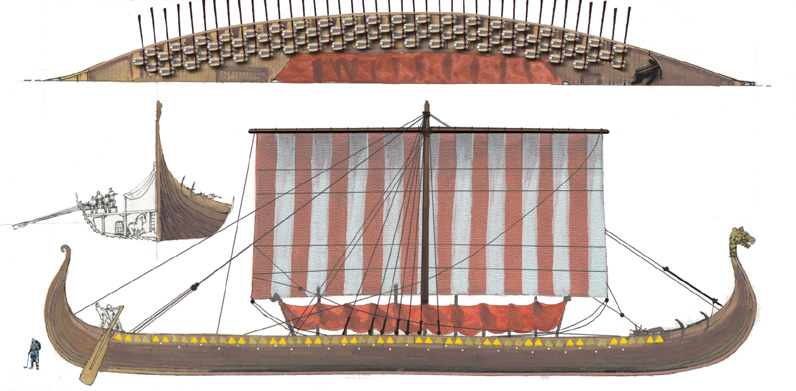 |
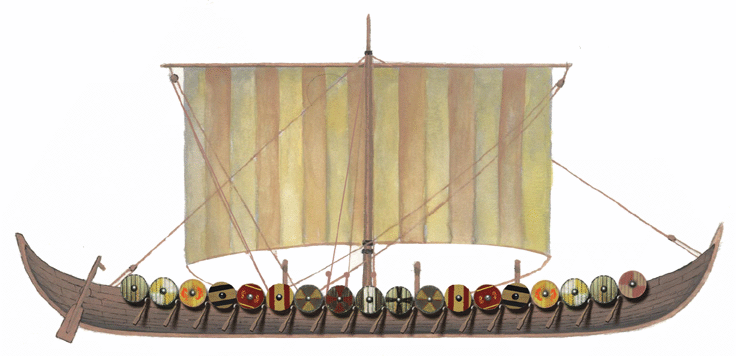 |
| Lognship |
Navire servitude |
En 1066, se déroule un évènement important pour l histoire de l’Angleterre à savoir ‘invasion de Guillaume le Conquérant qui traverse la Manche avec son armée .Ses bateaux sont comparables par leur spécialisation à ceux du Jour J à Hastings, Guillaume bat et tue Harold
Croisades (5 à 7)
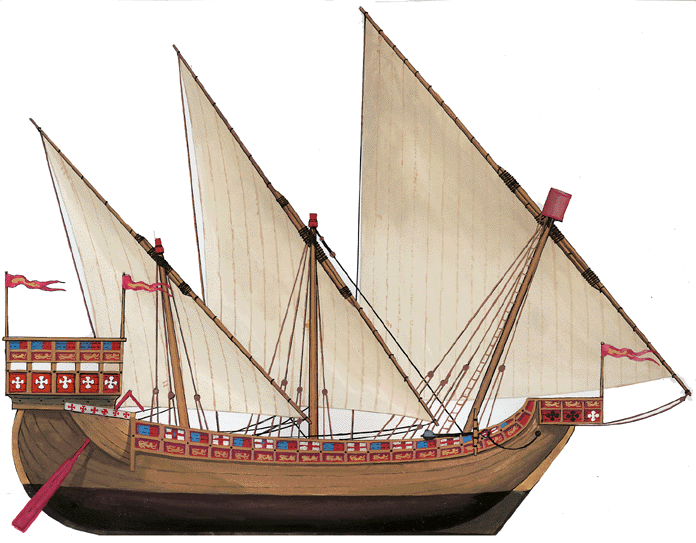 |
| Nef des croisés |
Les Croisés partent depuis les ports du sud de la France comme Aigues Mortes pour aller au Moyen-Orient
Guerre de 100 ans
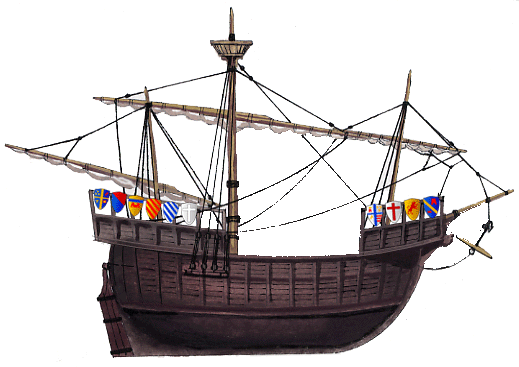 |
| Guerre 100 ans |
En Juillet de 1346 Edouard III, et son armée envahissent la Normandie. S’en suit la Guerre de Cent Ans
Invincible Armada 1588
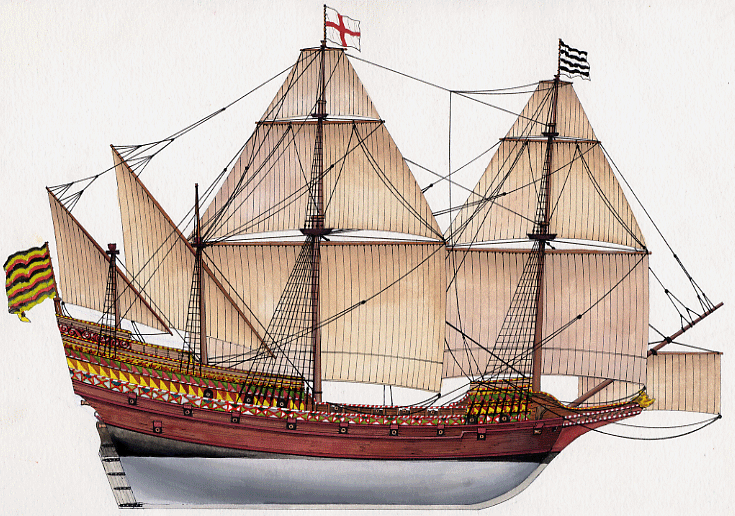 |
.gif) |
| Galion Anglais |
Galion Espagnol |
Vous arrivez maintenant à l'été 1588 lorsque l'Armada espagnole avec des navires de guerre et transports se dirige vers l’Angleterre.
Mais la flotte anglaise avec Drake et le mauvais temps dispersent la Flotte espagnole et met fin à leurs espoirs d’invasion
Méditerranée expédition d’Alger 1775
En mer Méditerranée en 1775, les Espagnols envoient t51 navires de guerre et 344 transports vers le Maroc et Alger mais en Juillet 1775 le débarquement en baie d'Alger, a été un désastre pour la flotte espagnole
France Camp Boulogne 1804
Vous arrivez au cours de la période napoléonienne avec la tentative d’ invasion de l'Angleterre par les troupes françaises
Conquête de l’Algérie débarquement de Sidi Ferruch 1830
Conquête de l'Algérie après le débarquement de Sidi Ferruch 1830
Vera Cruz au Mexique En 1847
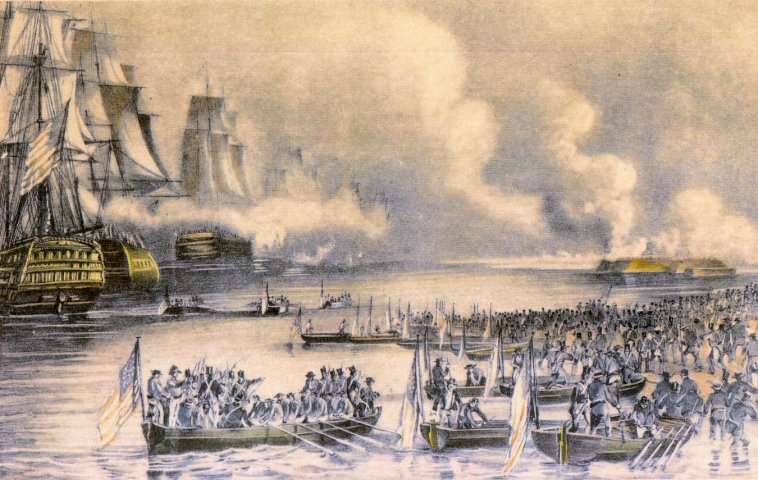 |
| Debarquement Vera Cruz 1847 |
les troupes américaines de Winfield Scott debarquent grâce à des bateaux spécialement conçus pour le débarquement
Guerre de Crimée 1853 1856
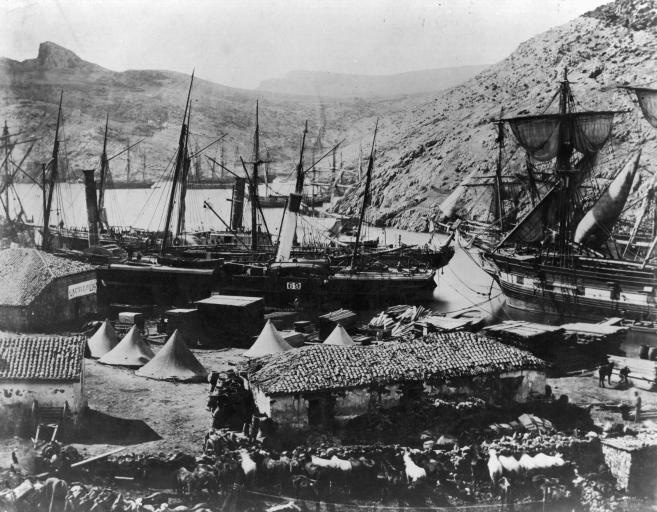 |
| Guerre de Crimée |
Guerre de Sécession 1861 1865
Diverses opérations de débarquement ont lieu durant la Guerre de Sécession
Goose Creek, Cumberland Pamunkey River. Durant cette opération l’Armée du Potomac utilisa des barges
Guerre du Mexique 1862 1867
Intervention français au Mexique
Guerre Hispano Américaine 1898
Les troupes américaines sous le commandement de William Shafter debarquent à Daiquiri et Siboney à Cuba, 1898
Dardanelles 1915
 |
| Gallipoli 1915 |
Gallipoli Au cours de 1° Guerre Mondiale la seule grande Opération de débarquement
2° Guerre Mondiale
C’est pendant la 2ème GM que noud pouvons assister à de grandes opération amphibies
Les matériels utilisés pendant la Seconde Guerre mondiale.
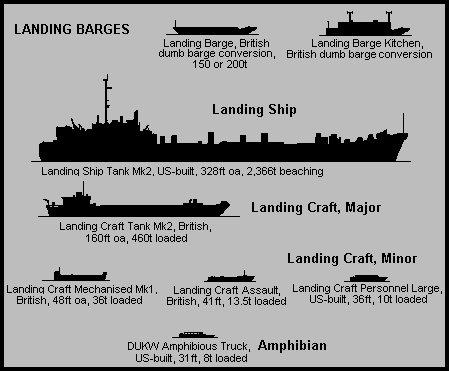 |
| Source Internet |
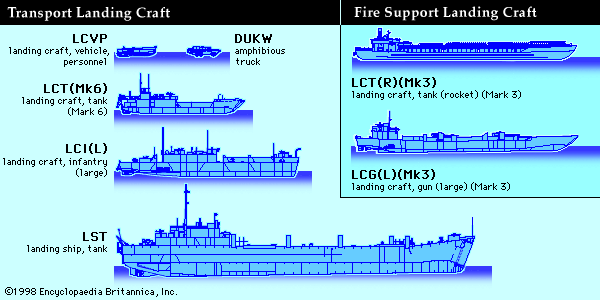 |
| Source Internet |
Famille d'engins de débarquement.
LCP, LCV, LCVP
LCVP.
Construit par Andrew J. Higgins Boat Company en avril 1943. 11metres de long avec des capacités de transport de 34 soldats ou un camion.
LCM
Engins de débarquement d’engins mécanisés.
La rampe d'étrave est une idée apparue en 1926. Le LCM est un modèle d’origine britannique. Le premier prototype, MLC, est sorti en 1938. Les premiers essais du LCM Mk1 ont lieu en Février 1940. Il a 13,5 metres de long et a été conçue pour le transport d’un char de 16 tonnes
Aux États-Unis, Higgins l’ expérimente et y apporte des modifications à l'avant et construit le LCM it Mk3.
L'armée américaine a acheté des LCM (également appelé MK4) qui a une largeur suffisante rajoutée de sorte qu'il pouvait transporter des chars Sherman de 30 tonnes.
Famille camions amphibies
DUKW. D(année modèle),U (amphibie), K (toutes roues motrices), W (double essieu arrière).
"Construisez moi un camion qui peut nager." Tel est le défi
2 ingenieurs Rod Stevens concepteur de bateau, et Dick Kerr, speciaiste du transports chez Arabian-American Oil Company. C.p. conçoivent un projet accepté par la National Defense Research Committee (NDRC), qui est evenu le Bureau de la recherche et le développement (OSRD). En 1942, ils décident de convertir un GMC 2 ½ tonne en camion amphibie . Le modèle a été adopté en Octobre 1942.
Port Artificiel ou système Mulberry
Jetée flottante.
Ponton.
Les Unîtes Américaines Amphibies de la 2° Guerre Mondiale
Ces Engineer Special Brigades sont des spécialistes qui dirigent les débarquements amphibies et aident pour la remise en conditions des Ports u port Commandes.
On trouve les unités suivantes
1re, 5e et 6e ESBS dirigent les débarquements sur les MTO ETO (Méditerranean European Theater) et les . 2e, 3e, et 4e ESBS dirigent les débarquements sur PTO (Guerre du Pacifique).
Opérations MTO (Mediterranean Theater)
8 Novembre 1942. Opération Torch
Afrique du Nord. Oran, 3e Cie Port.
9 / 10 juillet 1943 Opération Husky
LaVita Sicile,. 10ème cie Port.
9 Septembre 1943 opération Avalanche
Salerne et de Naples, en Italie. 6ème Cie Port.
23 janvier1944 Opération Shingle
Anzio. 10ème Cie Port.
Opérations ETO (European Theater)
6 Juin 1944. Opération Overlord
France.Normandie, 11 Cie Port.Arromanches
Juin 1944.
Normandie Cherbourg. 28 jours avec des DUKWs jusqu'à ce que le port a été réhabilité. 4e Cie Port
15 août 1944. Opération Dragoon / Anvil
Sud de la France. 6ème Cie Port.
2 Octobre 1944.
France Le Havre, France. 16ème Cie Port.
PTO
Différents débarquements
Guerre froide.
Après l'opération Overlord, nous devons attendre la Guerre de Corée pour voir des opérations LOTS
Toutes les Engineer Special Brigades ont été dissoutes après la Seconde Guerre mondiale, sauf la 2e ESB
Guerre de Corée
Participation aux débarquements à Inchon, Corée, les 15et 16 Septembre 1950, et Iwon, du 29 Octobre au 8 Novembre 1950 mais en 1954, la 2nd Engineer Special Brigades est dissoute et le 159th Boat Battalion recoit ses attributions (débarquements s. Transport par bateau débarquements et exploitation de ceux-ci ).
Matériels
Engins de débarquement.
LCM 8. Construit en 1955 et affecté au CoSA - D, 159th Boat Battalion
LCU 1466.
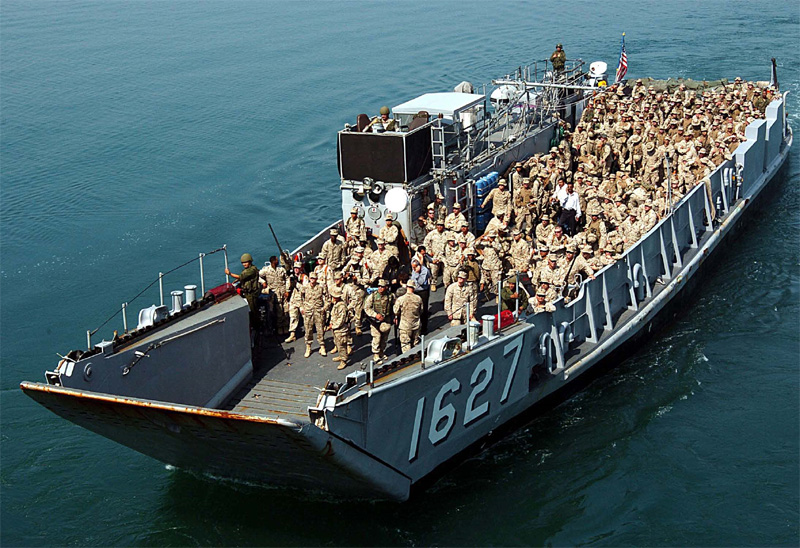 |
| Source Internet |
Construit en 1952 et affecté à la 329ème Trans Co. Du 159e Bn.
Camions amphibies
Super DUKW.
L'Armée de terre a besoin d'un véhicule qui soit un bateau dans l'eau et un camions sur terre.
LARC V (( Lighter Amphibious Resupply Cargo). En 1956, le US Army Research Command (USATRECOM) lance l’étude d’un engin pouvant aussi bien naviguer que rouler sur terre ferme
Un prototype a été construit en 1959 et es essayé jusqu’en Juillet 1963.
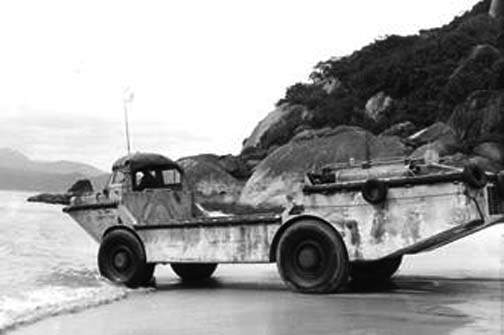 |
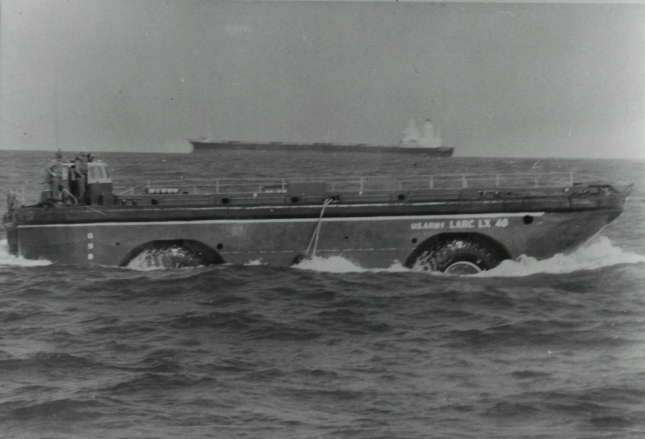 |
| Larc V Source Internet |
Larc XV Source Internet |
C’est le LARC V mis en œuvre par les165e, 305e, 344e, 458e, 461e active Transports Companies
En 1960 arrivent les LARC XV de 15tons capacité.
Port Artificiel.
Delong PEIR. Utilisée pour la première fois en 1951 à Thulé, au Groenland, Opération Blue Jay
par l'USAAF
.gif) |
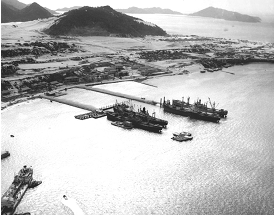 |
| Source Internet |
Source Internet |
Aerial Tramway système.
Se sont deux tours qui sont connectées à un Delong PEIR et à la rive par deux câbles Ce système a été développé par John A. Roeblings' Sons, de Trenton Corp.
Il a la capacité de pouvoir être utiliser là ou il n y a pas de plages et où les engins amphibies ne peuvent évoluer comme des falaises abruptes
Utilisé du 14 au 18 Novembre 1955 lors de l’opération TRAMTEST par la 577e Aerial Tramway Company, à Little Creek qui est devenu l’unité d active de l'Armée de terre Les 408e et 458e ont été placées dans la Réserve.
Floating Causeway
Exercices CONEX, Exercices, 1950-1964.
Ces exercices au large de la rive nord de la France ont été menées pour tester de nouveaux concepts dans le cas où l'URSS détruise les ports avec des bombes nucléaires.
Offshore décharge (ODEX). Supply-over-the-beach ou opérations au large de la côte nord de la France.
A cette epoque le nom qualifiant cette opérations a été modifiée de Supply-over-the-beach en LOST
Nouveau exercice NODEX en 1964 lorsque la France quitte l'OTAN .
LOTS opérations.
Opération Blue Jay, été 1951.
Construction de la distance Early Warning (DEW) Line, qui s'étend de l'Alaska à travers le cercle polaire arctique au Groenland pour surveiller le ciel par crainte d’attaque par Bombardiers sovietiques.
Support Northeastern Command (SUNEC) 1953-65.
Tous les engins de débarquement ont été prépositionnées avec des équipages afin d’appuyer à partir de Thulé la DEW Line.
1958. Crise au Liban, Khaldé, près de l'aéroport de Beyrouth,
Guerre du Vietnam.
1965-1973Cam Ranh Bay et de Qui Nhon,
Toutes les unités arrivant au Vietnam ont été débarqués par LCM s (s ship-to-shore )
Après construction de DeLong Piers , les LST ont été utilisés pour décharger des munitions. Pour des raisons de sécurité, les navires ont dû rester au large.
1965-1973. Delta du Mékong (IV Corps Tactical Zone),
I° Corps Tactical Zone
Face à la nature des plages il a été construit des DeLong Piers, de sorte que le ravitaillement a été principalement réalisée par débarquement sur la d’où la nécessité de prévoir une plage de soutien,
1967 Sau Hugynh,. LOTS
Cette opération menée par la 159e Terminal Bataillon en faveur d'une brigade de la 101e Air borne Division à Duc Pho le long de la route côtière.
Celle ci a été menée par des engins de débarquement.
Sau Hugynh possède une cote protégée naturellement alors que la plage de Duc Pho est une plage ouverte sur l’océan donc avec une mer agitée. .
1968. Bataille de Hue
Les convois arrivent jusqu'à la rivière Viet Qua à Hue et ensuite par la Rivière des Parfums à Dong Ha afin de livrer les fournitures.
Après l’ Offensive du Tet, l'armée américaine a établi un poste de commandement logistique à Danang dans CTZ e et l’Army continue de ravitailler Dong Ha alors que la marine s’occupe de Hue.
Mars à Septembre 1968. Wunder Beach, 159th Terminal Bataillon appuie la 1ère Division de cavalerie dans la levée du siège de Khe Sanh et renseigner sur les mouvement de la NVA dans la zone d’ Ashau Valley.
1968.t Vung Ro Bay.
L’AprèsVietnam - Guerre froide.
Materiels Amphibies.
LACV 30.
.jpg) |
| LAVC Source Internet |
3ème génération d'amphibiens. qui est mis en étude en 1978, pour être mis en service en 1983. Testé pour la première fois au cours de Offshore Discharge of Container Ship Exercise II (OSDOCII) à Ft Story, VA. Il a été conçu pour remplacer les LARCs car sa vitesse diminue les temps de chargement et de déchargement et son autonomie
Par contre il présente des inconvénients :Son coût et son entretien fastidieux (8 heures régulièrement ).
Engins de débarquement.
LCU 1600, 1976
LCU 2000. Construit par Lockheed Shipbuilding Corp chantier naval de Thunderbolt, GA. livrés en 1988.
LSV. Logistical Support Vessel Navire de soutien logistique. 1987 Inspiré par le succès de l'USAT UD John Page et son successeur, le Bunker USAT.
Operations Après-guerre froide
1982 Malouines operation Corporate
Rough Terrain Cargo Handler (RTCH), 1984.
Panama. 11 Mai 1989 Opération NIMROD Dancer.
Panama. Début 21 Décembre 1989 Opération Just Cause
Golfe Perqique 1990 1991 Desert Shield/Storm Salamendre (français) Telic (UK)
Somalie, 1994 l'opération RESTORE HOPE,.
Haïti, 1994 1995. Opération PROMOTE LIBERTY,
Irak 2003 Operation. IRAQI FREEDOM, (OIF)
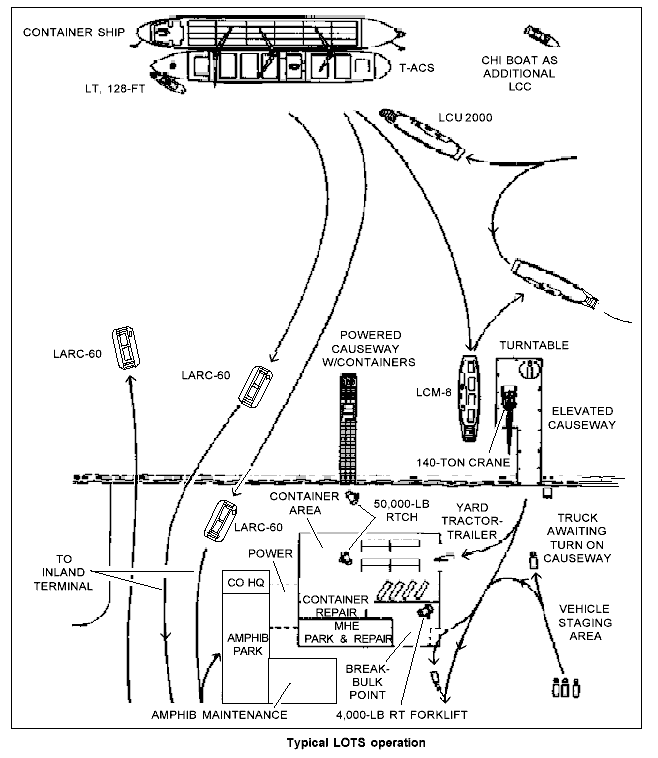 |
History of Logistics-Over-The-Shore Operations (LOTS)
It is the capability to provide logistical sustainment to landed forces on beach where deep draft shipping cannot arrive or where ports are inaccessible or denied With the apparition of the Aircraft some operation may be conduct by air landing
Little History of some major beach operation.
Troy War XIII° AD JC
 |
| Mycenian ship |
To avenge his honnor ( his wife Helen was rapted by Piran son of the King of Troy ) Menelas Sparta king with his brother Agamemnon Mycens king quickly assembled an amphibious force (1000 ships follow the legen ) with the help of other Greek rules, and, in 1183 B.C. they attack Troy city of Priam The Greeks crossed the Aegean Sea and hit the beach near Troy. The war will be continued ten years
Medic War V° siecle AD JC
 |
 |
| Phenician ship (Persian fleet) |
Athenian Trier |
700 years later the Persian King Darius, launched a water-borne attack against the Greeks in 490 B.C.
Darius constructed an especially designed amphibious fleet for an attack on Athens. His shipbuilders developed a very remote ancestor to the LCM, a landing craft with a runway to let horses ashore. This "LCH" (landing craft, horse) failed to conquer the Greeks, however, and Darius made his landing only to be defeated in Salamina
Syracuse 413 AD JC
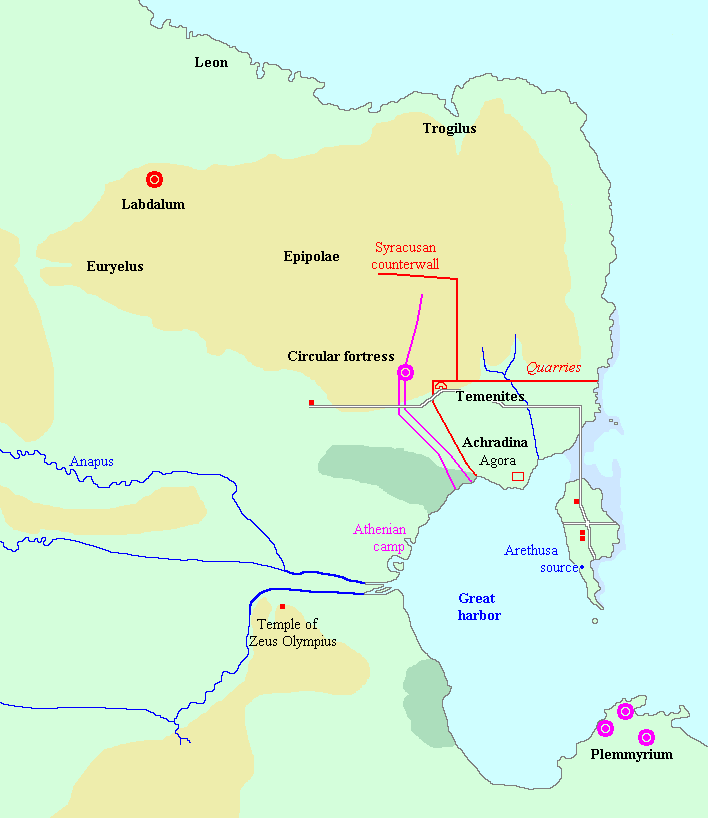 |
| Seat of Syracusa |
the siege of Syracuse in Sicily by the Athenians , but failed to take the city Syracusa was help by Sparta
Britan (Albion) Conquest by Roman Army
 |
 |
| Roman Trirem |
Roman Pentacontere |
In 55 B.C. Julius Caesar landed temporary two legions in Britain, but withdrew them after a short while but an year later he return and defeat the English “king” Cassioelaunus.
England Invasion, 1066 by Willian the Conqueror
 |
 |
| Bayeux Tapestry |
Bayeux Tapestry |
 |
 |
| Longship |
Merchant ship |
In 1066 we found one of the most historically important water borne invasions when William the Conqueror crossed the English Channel to Britain with his army
His boats were comparable in length to the smaller landing boats used today and were driven up onto the beach by rowers and a "coxswain" who directed the boat with a large steering oar. At Hastings, William defeated Harold
Crusades V° VI° VII°
 |
| Crusades Nef |
The Crusader Navy h go to Middle East from the ports of the south of France like Aigues Mortes
Hundred Years war
 |
| 100 years Ship |
In July of 1346 Edward III, and his English army invaded Normandy. follow the beginning of the Hundred Years Wars
Invincible Armada 1588
 |
.gif) |
| English Galion |
Spanish Galion |
You arrive now in summer 1588 when the Spanish Armada with warships and transports beat its way up the channel.
But the manoeuvrable English fleet with Drake smashed both the Spaniards' ships and their invasion fail
Algier expedition 1775
In Mediterranean sea in 1775 the Spaniards sent 51 naval vessels and 344 transports to invade Morocco and smash the Moors. Early in July a landing was attempted in the Bay of Algiers but it was a disaster for the Spanish Fleet
France Boulogne Camp 1804
You arrive during the Napoleonic periods with the endeavour of the England invasion by french troops
Algeria Conquest
Landing of Sidi Ferruch 1830 and begin of the conquest of the Algeria
Vera Cruz, Mexico, 1847
 |
| Vera Cruz 1847 |
. Winfield Scott’s landing at QM Gen Jessup had special landing barge designed to land troops
Crimea War 1855
 |
| Crimean War |
ACW
McClellan’s 1862 Peninsula Campaign. In-stream discharge. Goose Creek, Cumberland Landing and White House Landing on the Pamunkey River. At White House Landing, Army of the Potomac beached barges at high tide then built wharves out to them
French Intervention in Mexico
American Spanish War 1898
Cuba, 1898
landing at Daiquiri and Siboney by William Shafter.
WW1
 |
| Gallipoli 1915 |
Dardanelles Galipoli
During WW1 the only major sea-to-land invasion was the Gallipoli intervention in 1915 1916
But it is the WW2 who see a large utilisation of this operations
Materials used during WWII.
 |
| Internet Source |
 |
| Internet Source |
Family of Landing Craft.
LCP, LCV, LCVP
LCVP
Built by Andrew J. Higgins Boat Company in April 1943. length 11meters Capability of hauling 34 soldiers or one truck.
LCM
Landing Craft Mechanized. The hinged bow ramp idea originated in 1926. The LCM was a British design. The first prototype, Motor Landing Craft, came out in 1938. The first trials for the LCM Mk1 took place in February 1940. It was 13.5 meterst long and was designed to transport a 16-ton tank. In the United States, Higgins experimented with modifications to the bow and built the LCM Mk3.
The US Army bought the LCM 6 (also referred to as the Mk4) which had a 1.82meters section added so it could transport the 30-ton Sherman tank.
Family Amphibious Trucks
DUKW. D (model year), U (amphibian), K (all-wheel drive), W (dual rear axle).
“Build me a truck that can swim.” That is the challenge
Rod Stevens a boat designer, and Dick Kerr, transportation specialist for Arabian-American Oil Company. P.C. conceived the project accepted by the national Defense research Committee (NDRC) which became the Office of Strategic Research and Development (OSRD). In 1942, they decided to convert a GMC 2 ½-ton truck to amphibian capability. The pattern was standardized in October 1942.
Prefabricated port
Floating causeway.
Pontoon bridge.
Mulberry system.
US Units of the WW 2
Engineer Special Brigades (ESB)
Engineer Special Brigades (Amphibious Engineers) are specialists troop who conduct
amphibious landings and handed off the over-the-beach operations to the Port Commands.
1st, 5th, and 6th ESBs conducted the landings in MTO an ETO( Mediterranean, and European Theater Operation ) and. 2nd, 3rd, and 4th ESBs conducted the landings on PTO ( Pacific Theater ).
WW2 Opérations Over-the-beach MTO (Mediterranean Theater )
North Africa, operation Torch
8 November 1942. Oran, North Africa. 3rd Port.
Mediterranean,.(MTO)
9/10 july 1943 Operation Husky
Sicily Lavita,. 10th Port.
9 September 1943 operation Avalanche
Salerno and Naples, Italy. 6th Port.
23 january1944 Operation Shingle
Anzio. 10th Port.
WW2 Opérations Over-the-beach ETO ( European Theater )
6 June 1944. Operation Overlord
France.Normandy, 11th Port. Arromanches
June 1944.
Normandy Cherbourg . 28 days DUKWs through the break wall until the port was rehabilitated. 4th Port
15 August 1944. Operation Dragoon /Anvil
Southern France. 6th Port.
2 October 1944.
France Le Havre, France. 16th Port.
PTO
Differents landings
Cold War.
After the operation Overlord in we can wait Koeran War to see over LOTS operations
All Engineer Special Brigades were inactivated after WWII except the 2nd ESB
Korean War
It participated in the landings at Inchon, Korea, 15-16 September 1950 and Iwon, Korea, 29 October to 8 November 1950 but in 1954 the 2nd Engineer Special Brigade was inactivated and 159th Boat Battalion assumed the responsibility for combat landings and LOTS. Transportation boat companies will conduct both landings and terminal operations.
Materials
Landing Craft
LCM 8. Built in 1955 and issued to Co.s A – D, 159th Boat Battalion
LCU 1466. Built in 1952 and issued to the 329th Trans Co., 159th Bn.
 |
| Internet Source |
USAT John U.D. Page. Largest Army watercraft of its kind.
Amphibians trucks
Super DUKW. Handled like a truck that could swim. The Army needed a vehicle that handled like a boat in the water and truck on land.
LARC V ( Lighter Amphibious Resupply Cargo). In 1956 the US Army Research Command (USATRECOM) research to build a boat with the ability to drive on land. prototype was built in July 1959 to 1963. It was the LARC V and it was handle by the 165th, 305th, 344th, 458th, and 461st active Transports Companies
 |
 |
| Internet Source |
Internet Source |
In 1960 arrive the LARC XV of 15tons capacity.
Prefabricated port.
.gif) |
 |
| Internet Source |
Internet Source |
Delong Peir. used fot the first time in 1951 in Thule, Greenland, Operation BLUE JAY By the USAAF
Aerial Tramway system.
It was a two towers that connected a DeLong floating pier to the shore by two track of aerial cable and four cargo cars, that operated like elevated street cars. This system was devolopped by John A. Roeblings’ Sons, Corp. of Trenton .He had the capability to conduct offshore discharge where there was no beach on which landing craft or amphibians could land such as steep cliffs14-18 November 1955 Operation TRAMTEST. By the 577th Aerial Tramway Company, at Little Creek who became the Army’s only active duty aerial tramway company. The 408th and 458th were in the Reserves.
Floating Causeway
CONEX, mid 1960s. Exercises, 1950-1964.
These exercises off the northern shore of France were conducted to test new conceptsn in the event the USSR destroyed ports with nuclear bombs.
ffshore Discharge Exercise (ODEX). Supply-over-the-beach Operations off the Northern Coast of France.
In this time the name of this operations was changed to supply over-the-beach (SOB)on logistics-over-the-shore (LOTS) .
New Offshore Discharge Exercises (NODEX). 1964. in France when NATO leave this country .
LOTS Operations.
Operation BLUE JAY , summer 1951.
373rd Transportation Major Port, Thule, Greenland.
Construction of the Distance Early Warning (DEW) Line, which stretched from Alaska across the Arctic Circle to Greenland to watch the skies for the feared bomber attack by Russia.
Support Northeastern Command (SUNEC) 1953-65.
All landing craft were prepositioned so crews from Ft Eustis deployed to Thule to conduct LOTS to support the DEW Line.
1958. Lebanon Crisis, Khalde, near Beirut Airport,
Vietnam War.
1965-1973Cam Ranh Bay and Qui Nhon,
All units arriving in Vietnam were landed by LCMs for ship-to-shore. After the DeLong Piers were established, the LST beaches were used for the discharge of ammunition. For safety reasons, ammunition ships had to remain off shore.
1965-1973. Mekong Delta (IV Corps Tactical Zone),
I Corps Tactical Zone. The shallow nature of the beaches in I Corps did not make it practical to build piers, so the resupply was primarily conducted by beach operations. Because of the need for beach support,
1967 Sau Hugynh,. This LOTS operation conducted by the 159th Terminal Bn supported a brigade of the 101st Abn Div at Duc Pho along the coastal highway. This was conducted by landing craft. Sau Hugynh had a protected shore while the beach at Duc Pho was open ocean subject to rough seas.
,1968. Battle of Huen convoys up the Qua Viet River to Hue and the Perfume River to Dong Ha to deliver supplies.
After the Tet Offensive, the US Army established the DaNang Support Command in I CTZ and the Army continued to deliver cargo to Dong Ha and the Navy Ramp at Hue.
March to September 1968. Wunder Beach, 159th Terminal Bataillon supported the 1st Cavalry Division in its operation to break the seat of Khe Sanh and clear the NVA out of Ashau Valley. 1968.at Vung Ro Bay, .
Post Vietnam – Cold War
Amphibians. Materials
.jpg) |
| Internet Source |
LACV 30. 3rd generation of amphibians. . Type classified in 1978, in use by 1983. First tested during Offshore Discharge of Container Ship Exercise II (OSDOCII) at Ft Story, VA. It was designed to replace LARCs because its speed improved the time of loading and unloading and its range. Its drawbacks were its costs and 8-hours of routine maintenance.
Landing craft.
LCU 1600, 1976
LCU 2000. Built by Lockheed Shipbuilding Corp. Shipyard in Thunderbolt, GA. delivered in 1988.
LSV. Logistical Support Vessel. 1987 Inspired by the success of the USAT John U. D. Page and its successor the USAT Bunker.
Post Cold War Operations
Malouines Sping 1982 Operation Corporate
Rough Terrain Cargo Handler (RTCH), 1984.
Panama. 11 May 1989 Operation NIMROD DANCER.
Panama. Beginning 21 December 1989 Operation JUST CAUSE.
Persic Gulf 1990 1991 Desert Shield/Storm Salamender (french) Telic(UK)
Somalia, 1994 Operation RESTORE HOPE,.
Haiti, 1994 1995. Operation PROMOTE LIBERTY,
Irak 2003 Operation.IRAQI FREEDOM, (OIF)
Authorization for ship drawing from Navystory







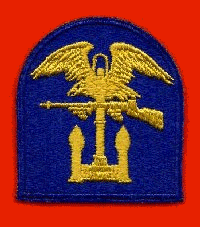



.gif)









.gif)








.gif)

.jpg)

